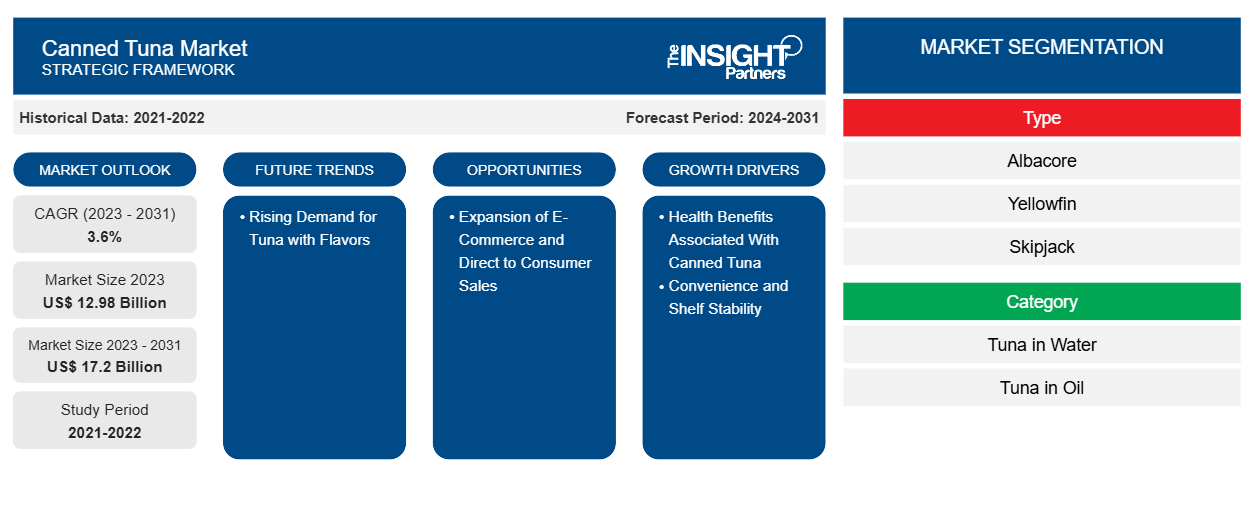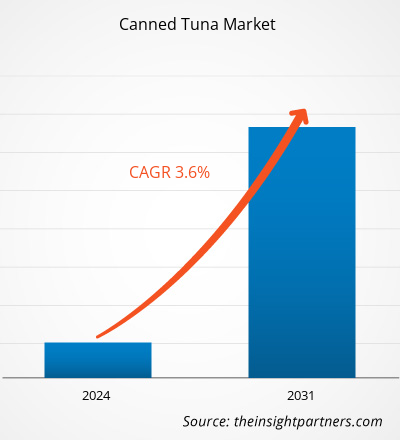[Research Report] The canned tuna market was valued at US$ 12.98 billion in 2023 and is expected to reach US$ 17.20 billion by 2031; it is estimated to record a CAGR of 3.6% during 2023–2031.
MARKET ANALYSIS
Canned tuna, a processed form of tuna, is a versatile ingredient that can be used directly in a wide range of recipes, including salads, sandwiches, cutlets, spring rolls, and various pasta dishes. The increasing number of health-conscious consumers seeking convenient protein sources, along with a growing reliance on ready-to-cook and ready-to-eat food products, has driven the expansion of the canned tuna market. Furthermore, changing dietary preferences, fueled by the growing awareness of the nutritious health benefits of tuna, have contributed to the market's growth. Additionally, strategic initiatives such as product launches, developments, mergers, acquisitions, and collaborations by key market players have also played a significant role in the expansion of the canned tuna market. Notably, in March 2021, Thai Union’s SEALECT Tuna brand introduced a limited-edition series of canned tuna featuring a packaging design with Doraemon, aimed at attracting consumers coinciding with the release of The Movie - Standby Me Doraemon 2.
E-commerce and direct-to-consumer (D2C) platforms provide brands with a direct channel to reach consumers and bypass traditional retail distribution channels. With the increasing popularity of online shopping and the convenience of purchasing groceries online, canned tuna brands can leverage e-commerce platforms and their websites to expand their reach and accessibility to consumers. By establishing an online presence, brands can showcase their products, communicate their brand story, and engage directly with consumers, fostering stronger relationships and brand loyalty.
Moreover, the shift toward e-commerce and D2C sales offers canned tuna brands greater control over their marketing strategies, pricing, and promotions, enabling them to tailor their offerings to meet their target audience's specific needs and preferences. Brands can leverage data analytics and consumer insights to personalize marketing campaigns, optimize product assortments, and create targeted promotions that resonate with online shoppers. Additionally, D2C sales allow brands to collect valuable consumer feedback and insights, enabling them to continuously improve their products and customer experience based on real-time feedback.
Furthermore, expanding e-commerce and D2C sales channels allows canned tuna brands to experiment with new product offerings, packaging formats, and value-added services to differentiate themselves in the market and drive consumer engagement. Brands can introduce exclusive online-only products, limited edition flavors, or subscription services that incentivize consumers to purchase directly from their website. Additionally, market players can offer convenient features such as auto-replenishment options, recipe suggestions, and educational content to enhance the online shopping experience and encourage repeat purchases. Overall, the expansion of e-commerce and D2C sales channels can help canned tuna brands deepen their relationships with consumers, drive sales growth, and stay ahead in a competitive market landscape. Thus, expanding e-commerce and D2C sales through company websites would present a significant opportunity for the canned tuna market during the forecast period.
GROWTH DRIVERS AND CHALLENGES
Canned tuna is a valuable source of high-quality protein, essential for the repair and maintenance of tissues, muscles, and organs. Its protein content also contributes to a sense of fullness, making it a satisfying and filling choice for individuals looking to manage their weight or increase muscle mass.
Canned tuna contains omega-3 fatty acids, particularly eicosatetraenoic acid (EPA) and docosahexaenoic acid (DHA). These fatty acids are known for their numerous health benefits, including reducing the risk of heart disease, improving brain function, and supporting overall cognitive health. Incorporating omega-3 fatty acids into the diet through canned tuna consumption can help consumers maintain a healthy heart and brain function.
Furthermore, canned tuna is a good source of various vitamins and minerals, including vitamin D, vitamin B12, selenium, and potassium. Vitamin D is essential for smooth immune function and bone health, whereas vitamin B12 supports nerve function and red blood cell production. Selenium is an antioxidant, protecting cells from damage, and potassium helps regulate blood pressure and muscle function. By consuming canned tuna, consumers can obtain these essential nutrients, contributing to good health and well-being.
Canned tuna is low in saturated fats and cholesterol; thus, it is a heart-healthy choice for individuals willing to reduce their risk of cardiovascular disease. The American Heart Association recommends consuming fish such as tuna at least twice weekly as part of a heart-healthy diet. As canned tuna contains protein, omega-3 fatty acids, vitamins, and minerals, it offers consumers a convenient and nutritious option to support their health goals, which drives the canned tuna market size.
Customize This Report To Suit Your Requirement
You will get customization on any report - free of charge - including parts of this report, or country-level analysis, Excel Data pack, as well as avail great offers and discounts for start-ups & universities
Canned Tuna Market: Strategic Insights

-
Get Top Key Market Trends of this report.This FREE sample will include data analysis, ranging from market trends to estimates and forecasts.
REPORT SEGMENTATION AND SCOPE
The "Global Canned Tuna Market Analysis" has been carried out by considering segments such as type, category, distribution channel, and geography. The report provides key statistics on the use of canned tuna across the world, along with their demand in major regions and countries. In addition, it provides a qualitative assessment of factors affecting the canned tuna market size. It also includes a comprehensive analysis of the leading players in the market and their key strategic developments. Canned tuna market analysis helps identify the canned tuna market trends, key driving factors, and lucrative opportunities that would, in turn, aid in generating higher revenues.
The ecosystem analysis and Porter’s five forces analysis provide a 360-degree view of the global canned tuna market, which helps understand the entire supply chain and various factors influencing the market growth.
SEGMENTAL ANALYSIS
The canned tuna market is segmented on the basis of type, category, distribution channel, and geography. Based on type, the market is segmented into albacore, yellowfin, skipjack, and others. The albacore segment holds the largest canned tuna market share. Albacore tuna/longfin tuna is found in tropical waters across the world. The canned albacore tuna is mostly labeled as “white meat tuna” due to its mild flavor and white flesh. Consumers, especially in France, the US, and Spain prefer albacore canned tuna due to its low-fat and high protein content with a mild flavor. Albacore meat is a versatile ingredient used in various dishes such as pastas and salads; it is also used as a substitute for chicken. Albacore tuna species is rich in omega-3 acids, proteins, minerals, and essential vitamins. This species is low in fat and mercury. Thus, the preference for canned albacore tuna is high among price-sensitive and health-conscious consumers. These factors drive the canned tuna market growth for the albacore segment.
Canned Tuna Market Regional InsightsThe regional trends and factors influencing the Canned Tuna Market throughout the forecast period have been thoroughly explained by the analysts at The Insight Partners. This section also discusses Canned Tuna Market segments and geography across North America, Europe, Asia Pacific, Middle East and Africa, and South and Central America.
Canned Tuna Market Report Scope
| Report Attribute | Details |
|---|---|
| Market size in 2023 | US$ 12.98 Billion |
| Market Size by 2031 | US$ 17.2 Billion |
| Global CAGR (2023 - 2031) | 3.6% |
| Historical Data | 2021-2022 |
| Forecast period | 2024-2031 |
| Segments Covered |
By Type
|
| Regions and Countries Covered |
North America
|
| Market leaders and key company profiles |
|
Canned Tuna Market Players Density: Understanding Its Impact on Business Dynamics
The Canned Tuna Market is growing rapidly, driven by increasing end-user demand due to factors such as evolving consumer preferences, technological advancements, and greater awareness of the product's benefits. As demand rises, businesses are expanding their offerings, innovating to meet consumer needs, and capitalizing on emerging trends, which further fuels market growth.

- Get the Canned Tuna Market top key players overview
REGIONAL ANALYSIS
The report provides a detailed overview of the global canned tuna market with respect to five major regions—North America, Europe, Asia Pacific (APAC), the Middle East & Africa (MEA), and South & Central America. Europe accounted for the largest global canned tuna market share, and the market in the region was valued at ~US$ 4,557.62 million in 2023. The market in Asia Pacific is expected to reach ~US$ 2,889.09 million by 2031. The canned tuna market in North America is expected to record a CAGR of ~3% during 2023–2031. The demand for canned tuna is significant in North America due to several growth drivers related to market dynamics and consumer preferences. The convenience factor significantly drives the demand for canned tuna in the region. With busy lifestyles and increasing time constraints, consumers in the region seek convenient and easy-to-prepare meal options that require minimal effort. Canned tuna fits this need perfectly, offering a quick and versatile protein source for various recipes such as sandwiches, salads, and pastas. A four-ounce serving of white tuna contains 26.77 grams of protein, 145 calories, and 3.37 grams of fat. It does not contain fiber, carbohydrates, and sugar. Also, its long shelf life and portability make it an ideal pantry staple for households looking for convenient meal solutions, contributing to the canned tuna market forecast growth in North America. Rising awareness of the health benefits of consuming seafood, particularly tuna, drives the demand for canned tuna in North America. After shrimp, canned tuna is the second most popular seafood product in the US. Tuna is rich in vitamins, minerals, high-quality protein, and omega-3 fatty acids, making it a nutritious option for health-conscious consumers. With an increasing focus on adopting healthier dietary habits and lifestyles, consumers in North America are actively seeking food options that offer nutritional value and support their overall well-being. Canned tuna provides a convenient and affordable way for consumers to incorporate seafood into their diets and reap its health benefits, driving the demand for canned tuna products in the region. Furthermore, the versatility of canned tuna makes it appealing to a wide range of consumers with diverse taste preferences and dietary needs. Canned tuna can be used in various cuisines and dishes, making it a versatile ingredient that can adapt to different culinary styles and preferences. Whether used in classic tuna sandwiches, salads, casseroles, or sushi rolls, canned tuna offers consumers endless possibilities for creating delicious and satisfying meals. Its adaptability and versatility make canned tuna a staple in many North American households, driving consistent demand for canned tuna products across the region.
COMPETITIVE LANDSCAPE AND KEY COMPANIES
StarKist Co; Bumble Bee Foods, LLC.; Chicken of the Sea; Wild Planet Foods; Genova; Conservas Ortiz S.A.; Century Pacific Food Inc; American Tuna Inc; Sustainable Seas and Pastene Co. are among the prominent players profiled in the canned tuna market report. In addition, several other players have been studied and analyzed during the study to get a holistic view of the market and its ecosystem. The canned tuna market report also includes company positioning and concentration to evaluate the performance of competitors/players in the market.
Frequently Asked Questions
Can you list some major players operating in the global canned tuna market?
In 2022, which region held the largest share of the global canned tuna market?
What are the drivers for the growth of the global canned tuna market?
Since more people are leading busy and mobile lifestyles, there is a growing preference for portable and convenient food options that can be prepared in minimal time. Furthermore, the versatility of canned tuna lends itself well to various meal occasions, further enhancing its appeal to consumers. Canned tuna can be incorporated into various recipes for different tastes and dietary preferences. It can be used in classic tuna sandwiches, salads, pastas, wraps, and casseroles. This versatility allows consumers to experiment with new flavors and meal ideas while still enjoying canned tuna's convenience and nutritional benefits. Overall, convenience and shelf stability make canned tuna popular among consumers seeking convenient and nutritious meal solutions.
Based on the category, which segment led the global canned tuna market in 2022?
What are the trends observed in the global canned tuna market?
Several brands have embraced the trend of flavored canned tuna by launching innovative offerings that cater to consumer demand for convenience, as well as diverse taste preferences and culinary trends. Bumble Bee Tuna introduced its Prime Fillet line that includes flavored canned tuna varieties such as lemon and pepper, sun-dried tomato and basil, and jalapeno, providing consumers with gourmet-inspired options for their canned tuna meals. Additionally, Starkist offers Tuna Creations pouches in various flavors such as hickory smoked, sweet and spicy, and ranch, allowing consumers to enjoy flavored tuna on the go. These brands' flavored tuna products exemplify the industry's response to changing consumer preferences and the growing demand for innovative and convenient canned tuna options. Therefore, the rising demand for flavored tuna products is expected to become a significant trend in the canned tuna market in the coming years.
Which type segment is the fastest growing in the canned tuna globally?
- Historical Analysis (2 Years), Base Year, Forecast (7 Years) with CAGR
- PEST and SWOT Analysis
- Market Size Value / Volume - Global, Regional, Country
- Industry and Competitive Landscape
- Excel Dataset
Recent Reports
Testimonials
Reason to Buy
- Informed Decision-Making
- Understanding Market Dynamics
- Competitive Analysis
- Identifying Emerging Markets
- Customer Insights
- Market Forecasts
- Risk Mitigation
- Boosting Operational Efficiency
- Strategic Planning
- Investment Justification
- Tracking Industry Innovations
- Aligning with Regulatory Trends





















 Get Free Sample For
Get Free Sample For